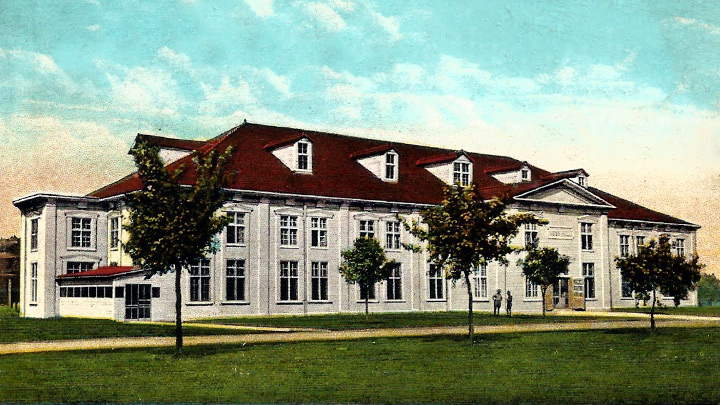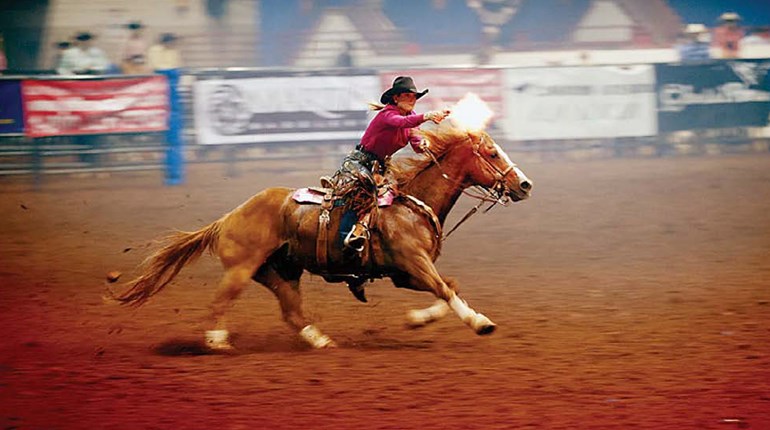
When I drove into Camp Perry at the start of the 2001 National Matches, the first thing that caught my eye (one tends to notice change) was a grading operation underway where the Mess Hall had been. The Mess Hall, damaged beyond reclamation in the tornado of 1998, was gone. It was enough, nearly, to break an old Perry veteran's heart. On the other hand, the tornado did more than just rip pieces off the roof of the old building and knock the chimney down (visible damage). It moved the whole structure partially off its foundation, cracked the walls and left them out of plumb. The place really could not be rebuilt.
It's a shame the end had to be like that. The Mess Hall was an architectural and engineering landmark. The construction method was, if not revolutionary, uncommon. The Mess Hall was not built, it was poured. The exterior was made of concrete sections that were formed on the ground around the perimeter of the building, allowed to harden and cure, and then raised into position using a derrick of some sort. Corners were fastened to internal pilasters and joints were sealed with concrete.
"The surface resembled an immense cakepan," reported1 the Ottawa County Republican for July 19, 1908, "in which are placed all the cornices, window and door frames with any molds for any ornamentation. The shell is then filled with concrete three and one-half inches deep and left to dry." The report continued, "Great care must be taken in raising the finished walls. However, the lifting apparatus is of such character as to apply uniform pressure, minimizing the danger of cracking the great blocks as they are placed in position. The plans picture a huge block house handled as a toy."
As built, the Mess Hall was 172 feet long, 62 feet wide and had two floors. The upper floor served for many years as an armory for the Ohio National Guard, converting more recently into administrative and classroom space used only occasionally. The ground floor was a Mess Hall (the 21st century euphemism is "dining facility") and a drill hall large enough to handle 1,000 soldiers. Though there were plenty of partitions—installed later—the structure was designed to stand with only a minimum of internal load-bearing supports.
In addition to its unique method of construction, the Mess Hall was the last significant structure (there are two others, less important: the commissary/warehouse immediately to the south of the Mess Hall site and the pumping station over by the water tower) that was both shown on the Ottawa County Engineer's map for 1909, and, up to 2001, was still standing. The farm houses and other wooden buildings that served as headquarters in the early years were torn down to make way for the arcade, the theater and post headquarters—all done in the 1930s as W.P.A. projects. The original water tower was a masonry structure over near the clubhouse. Today's water tower is made of steel and was built sometime in 1937. And the 1907-vintage clubhouse itself was torn down in 1993 and replaced by the present building.
And, there's the nostalgia to deal with. It's had to imagine how many shooters and families, match staff, soldiers detailed to the matches as scorers/target handlers, and since 1968, volunteers, passed through the serving lines (there were two) in that building. When Col. Mumma established his Small Arms Firing School at Camp Perry in 1918, the Mess Hall was used to feed the 500-plus students who comprised each of two classes, simultaneously in session. A local newspaper described it as the largest officers' mess in the country. And then there were five generations of Ohio National Guardsmen to add to the count and two generations of personnel going through the induction center in two world wars.
Chow, as I recollect, was usually pretty good too, though that depended on the cooks and bakers and the Mess Sergeant—the Dining Facility Manager. There's nothing like a good Army breakfast—eggs over easy, creamed chipped beef on toast (that's how "SOS" is listed in the Army Master Menu), or sausage, or bacon, a serving of fresh fruit, cereal and plenty of hot coffee—to get a day started. When you eat like that, you have to do more before 9 a.m. than most people do all day (a claim made by an Army recruiting ad of the 1990s). If you don't, every artery in your body will clog in about two weeks and none of your clothes will fit.
Anyway, it's a shame the old place had to come down. At least when they took it down, they took it all down. When I saw the site in July 2001, it was a rough grading project. By the end of the High Power Championships, the area had been seeded and grass was beginning to sprout. Today, the old Mess Hall site has been landscaped and turned into an attractive area for static displays of combat vehicles and aircraft used by the Ohio National Guard.
1Bovia, Anna—Camp Perry 1906-1991, published by the author, La Carne, Ohio, 1992, pp. 86-87.
See more: NRA: Early Foundation And Development 1871-1907

































